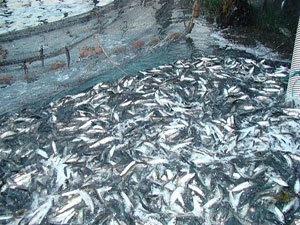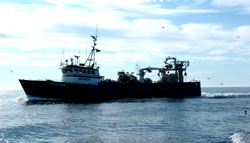 Bycatch has long been one of the major issues fishermen have had with industrial trawlers.This picture was taken from a whale watch trip on Sept. 3, 2003. The whale watch crew estimated that there were 200,000 to 500,000 dumped whiting bycatch by two 100 foot plus size herring pair trawlers. The dead fish covered a huge area. The location was near Mount Desert Rock. Fishermen's Voice photo Bycatch has long been one of the major issues fishermen have had with industrial trawlers.This picture was taken from a whale watch trip on Sept. 3, 2003. The whale watch crew estimated that there were 200,000 to 500,000 dumped whiting bycatch by two 100 foot plus size herring pair trawlers. The dead fish covered a huge area. The location was near Mount Desert Rock. Fishermen's Voice photo
|
beginning January 1, 2008, and for rules to make the change permanent. The Secretary is required to give full and prompt consideration to our request, and to respond within a ’reasonable’ amount of time. Given the emergency nature of the request, we expect a prompt response from the Secretary.”
Since the nineties, there has been a massive influx into the Gulf of Maine of large trawlers that target herring. Because of a loophole in the regulations, these vessels have been exempt from rules regarding closed areas. Since their arrival, fishermen from around the region have questioned the decision to allow these vessels into such important areas that are closed to rebuild groundfish and protect important spawning areas.
Despite years of strict regulations, groundfish are not rebuilding as quickly as some people believe they should. The petitioners and others believe that midwater trawling in the closed areas has hindered the rebuilding program.
“These areas are the last place you want midwater trawls,” said Craig Pendleton, coordinating director of Northwest Atlantic Marine Alliance, based in Saco, Maine. “If our fishing industry is going to survive, we need to stop overfishing and protect spawning grounds, not leave them open to giant midwater trawlers that wipe out everything in their path.”
Based on a small sampling of trips, though, managers decided years ago to allow these vessels to fish in areas closed for groundfish rebuilding. But as most everyone knows by now, these boats pose a serious threat to groundfish stocks. The very name ‘midwater trawl’ is deceiving; it is well known that these pelagic trawlers are capable of fishing anywhere in the water column, including near the bottom.
“As new scientific information becomes available, we see an increasing number of linkages between the emergence of the herring midwater trawl fishery and the continued poor health of New England’s groundfish populations,” said Roger Fleming. “There’s a mistaken assumption in current law that herring midwater trawlers are somehow incapable of catching groundfish. That’s simply not true and we are trying to correct that.”
Midwater herring trawlers began arriving in the region 15 years ago when NMFS advocated a growth in the fishery because of what they believed to be a significant biomass of herring off New England. The herring stocks offshore had collapsed completely in the late 1970’s and had slowly rebuilt to acceptable levels and apparently federal managers were eager to exploit this rebuilt stock. Midwater trawls began to account for more and more of the overall herring landings, eventually rendering the purse seine fleet to a minority player in the fishery.
Almost immediately, fishermen from all of the region’s major fishery and other coastal industries saw changes with midwater trawlers out on the fishing grounds. They came together six years ago and just last year were finally able to get some relief. The New England Fishery Management Council reacted to the thousands who spoke out and put in place a seasonal ban in the inshore Gulf of Maine. While the ban is a start, these vessels are still able to fish hard in closed areas for the eight months of the year not covered by the ban.
 Two 150' long trawlers, like the one pictured here, hauling enormous nets have unprecedented impact on fisheries. In the Gulf of Maine they target herring, but the fine mesh nets catch everything as they sweep over the Gulf. They are reported to fish at all levels in the water, including the bottom where ground fishermen say they are impacting groundfish protected for the mandated rebuilding effort. Fishermen's Voice photo Two 150' long trawlers, like the one pictured here, hauling enormous nets have unprecedented impact on fisheries. In the Gulf of Maine they target herring, but the fine mesh nets catch everything as they sweep over the Gulf. They are reported to fish at all levels in the water, including the bottom where ground fishermen say they are impacting groundfish protected for the mandated rebuilding effort. Fishermen's Voice photo
|
“These boats are 150 feet long and they tow a net as long as a football field, as wide as a soccer field and as tall as the U.S. Capitol building,” said Peter Baker of the Pew Environment Group which founded the Herring Alliance to protect New England’s population of herring. “They march up and down the fishing grounds. Juvenile groundfish don’t stand a chance. From the tuna, marine mammals and groundfish that feast on herring, to the lobstermen who use herring in their traps, these fish are fundamental to our ecosystem and our economy. We need to be smart about how we manage this critically important resource before it is too late.”
Steve Weiner, Chairman of the CHOIR Coalition (Coalition for the Atlantic Herring Fishery’s Orderly, Informed and Responsible Long Term Development), a group made up of tuna fisherman, groundfish fisherman, recreational fisherman and whale watch companies, agrees that something needs to be done to protect groundfish stocks from herring trawlers in the closed areas. “We all know that this gear can catch groundfish. It does not make any sense to close these areas to the groundfish fleet in order to protect groundfish, only to allow bigger boats with bigger nets to fish there, especially given the very low level of observer coverage on the herring trawlers.”
Observer coverage in the herring fleet is very low. For example, the herring fleet fished the entire month of May on Jeffrey’s Ledge, an area within the groundfish closures. During that time they landed roughly 17,000,000 pounds of herring. Yet, there were no observed trips during the massive effort that took place. Fishermen have serious concerns about the data pertaining to midwater trawl bycatch given such a meager level of coverage.
While groundfish fishermen have been involved in the fight against the herring trawlers over the years, the petition filed this month signals a greater level of involvement by the groundfish fleet. They are fed up with the rules that they believe are ruining the chance of a successful groundfish rebuilding.
“The current rules undermine our hard work to protect the New England fish stock and preserve a livelihood for future generations of fishermen,” said Glen Libby, commercial fisherman and chairman of the Midcoast Fishermen’s Association. “When the rules are applied unevenly, everybody suffers.”
So far neither the Secretary of Commerce nor NMFS has announced anything regarding the petition. Groundfish fishermen from this region are optimistic and hope that this action will finally drive the managers to push these large trawlers out of these areas that are essential to rebuilding the groundfish stocks that New England fishermen rely on.
|





